Assessment of Occupational Dust and Silica Exposure in Indian Stone Mining and Crushing Unit- A Case Study
Anand Arun Deshmukh 1
 , Nikhil Pradip Kulkarni 2
*
, Nikhil Pradip Kulkarni 2
*
 , Sarang Vilas Dhatrak 1
, Sarang Vilas Dhatrak 1
 and Subroto Shambhu Nandi 2
and Subroto Shambhu Nandi 2

DOI: http://dx.doi.org/10.12944/CWE.12.3.17
Stone crushing industry plays a vital role in the economy and urban development of fast developing countries like India. Stone mines and crushers in India are located around major cities and roughly employ around 5,00,000 peoples throughout the country. However this employment generating industry also happens to be one of the most dust generating activity and also a precursor to the respiratory disease, silicosis. This study was undertaken with an objective to estimate the personal exposure of the workers to silica laden dust in this industry sector. Personal dust sampling (n=11) and (n=6) was carried out in stone crushing and stone mining (quarry)areas respectively over a period of three consecutive days in selected units in a suburban area of Nalgonda district of Telangana state in India. The respirable dust exposure and free silica content was then estimated. It was observed that three (3) samples of crusher helper from the Crushing Unit had exposures exceeding the Permissible Limit Value (PLV) of Indian Factories Act1948. Two (2) Heavy Earth Moving Machineries (HEMM) operators from stone mining area were observed to have exceeded the Permissible Maximum Exposure Limit (PMEL) prescribed by the Indian Mines Act 1952 and subsequent rules their under. The remaining samples of HEMM operators from mining area and of the crusher helper from the crusher plant were observed to be within the prescribed limits of respective guidelines prescribed by the Indian statutory agencies. Two different acts were considered, because of the fact that stone mining is regulated by the Indian mining act and under the overall control of Directorate of Mines and Safety (DGMS), Government of India. On the other hand Crusher plant comes under the ambit of Model Factory Rule 120 under section 87 of Indian Factories Act 1948 under the overall control of Directorate General Factory Service and Labour Institute (DGFASLI) Government of India. Post the study it could be concluded that, stone crushers are dustier as compared to stone mining area. Workers in stone mining and crushing units of study area are indeed exposed to high levels of respirable and silica laden dust. It was observed that safety and precautionary measures towards dust and silica exposure are not implemented necessitating to be taken by unit operators.
Copy the following to cite this article:
Deshmukh A. A, Kulkarni N. P, Dhatrak S. V, Subroto, Nandi S. S. Assessment of Occupational Dust and Silica Exposure in Indian Stone Mining and Crushing Unit- A Case Study. Curr World Environ 2017;12(3). DOI:http://dx.doi.org/10.12944/CWE.12.3.17
Copy the following to cite this URL:
Deshmukh A. A, Kulkarni N. P, Dhatrak S. V, Subroto, Nandi S. S. Assessment of Occupational Dust and Silica Exposure in Indian Stone Mining and Crushing Unit- A Case Study. Curr World Environ 2017;12(3). Available from: http://www.cwejournal.org?p=1047/
Download article (pdf)
Citation Manager
Publish History
Select type of program for download
| Endnote EndNote format (Mac & Win) | |
| Reference Manager Ris format (Win only) | |
| Procite Ris format (Win only) | |
| Medlars Format | |
| RefWorks Format RefWorks format (Mac & Win) | |
| BibTex Format BibTex format (Mac & Win) |
Article Publishing History
| Received: | 2017-11-16 |
|---|---|
| Accepted: | 2017-11-29 |
Introduction
Metal and masonry stone, building material, etc play a vital role in urbanisation1 and today’s stone mining and crushing have become the backbone of infrastructure development in India.2–4 The finished product of stone crushing units in the form of crushed stone, stone chips of various sizes; plays a crucial role as a raw material for various construction activities viz. construction of roads, highways, bridges, buildings, canals, etc.5 Considering the pace with which India is developing and also the rate of urban sprawl; requirements of building materials such as crushed stone, aggregates, stone chips, etc are on the rise.
Stone mines and crushers are usually located near major cities and towns so as to cater to the growing demand of raw material and construction activities.3,5,6 Stone crushers range in size from large operations with many employees producing more than one million tons of material per year to small operations with 4 to 5 employees and supplying aggregate to local market. Being an unorganized sector, there is no reliable data available on total numbers of stone crushers in India. However, it is estimated that there are around 12,000 stone crushers employing around 5,00,000 people.7
Metal stones being classified as minor minerals in India, come under the ‘Mines and Minerals Development and Regulation Act 1957’.1 Further-on in a recent fillip, the Government of India has also given respective state governments an upper hand in dealing with minor minerals by giving them a nod over regulatory and administrative jurisdiction.2 However, the stone crushing units are regulated by the Factories Act 1948 and its amendment thereon in 1987.8
An expert group constituted by the Union Government of India identified “stone quarries and crushers” in India as a silicosis prone industry [9]. Silica is the most common mineral found in earth’s crust, with the most usual form of its presence being quartz.4,8 Grinding of metal stone which is known to contain silica is therefore known to enhance the risk of silicosis.4,10
Literature survey revealed that Suspended Particulate Matter (SPM) from stone crushers has detrimental effects on nearby flora and fauna.5,6,11 Respirable dust exposure studies in stone crushers are available in the present literature. However, stone mining and crushing unit together within the ambit of Indian Mines Act 1952 and Indian Factories Act 1948 for assessment of possible exposure to silica dust in India are scarce.
Sector background
Stone mining and crushing sector is well known for its association with dust generation.Stone mining usually starts with removal of overburden and extraction of material including fragmentation of the material by drilling and blasting. This is followed by mechanical excavation whereby hammers, rippers, excavators and other machineries are used based on the degree of mechnisation of the quarry.The extracted material consisting of stones of various sizes viz. fines are then temporarily stock piled at site. This is then transported to crushers using trucks, tippers and dumpers. A stepwise detail of stone quarrying and crushing is illustrated in Figure 1.
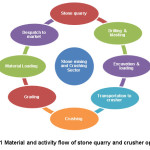 |
|
Based on the degree of mechanisation as well as the infrastructure available, stone crushers may have primary, secondary or tertiary crushers so as to process the incoming material to required size. Screening, sizing or other equipment with vibratory feeders and connecting conveyors are also common for separating the material into size fractions and conveying it to stock piles. Crushing stones are brought to the required sizes as per the industry demand and desired end use. Stone chips called “gitti” in local language are usually available in various sizes such as 0-4mm, 4-8mm, 8-12mm, 12.5-23mm and 23-40mm. These in addition are also accompanied by another end product - fine sand, which is also often stored in the premises and supplied as per requirement.
Standards and Legislation in Indian Context
Regulatory framework in India is quite developed and provisions for preventing workers from dust exposure are documented. However, enforcement and regulation are observed to be very poor.12 National Ambient Air Quality Standards (NAAQS) defines standards for regulating particulate matter concentration in industrial, residential as well as ecologically sensitive areas in the country.13 Environment Protection Act 1986 and its subsequent amendments have also imposed dust control measures.14
Stone mining is regulated by the Indian Mines Act 1952. The stone crushing industry, however comes under the ambit of Factories Act 1948. Ministry of Labour and Employment through Directorate General Factory Advice Service & Labour Institutes (DGFASLI) has framed Model Factory Rule 120 (MFR 120) by which “Manipulation of stone or any other material containing silica” is considered as a dangerous operation and process under section 87 of the Factory Act 1948. This rule has specifically outlined measures to be taken for the prevention of excessive exposure of dust in stone crusher settings. Further, the amendment in the Factories Act in 1987 has also set guidelines for calculating Permissible Limit Value (PLV) of dust laden with free silica.8
Materials and Methods
A cluster of stone mining and crushing units in the Nalgonda district of Telangana state, India were selected for the purpose of this study. Dust monitoring was conducted in four stone mines and their associated crushing units, each having capacities in the range from 100-250 TPH, in the month of March 2016.
Accordingly a total of seventeen (n=17) personal dust samples were collected using respirable dust samplers of SKC make (Model: Sidekick-51Ex). These were calibrated prior to sampling for a flow rate of 2.2 liters/min and the assembly of pre-weighed PVC filter paper was attached to the worker’s belt for the purpose of sampling for an entire working shift. Post sampling, the flow rate of the samplers and the difference in weight of the filter paper was noted. The concentration of dust collected and thus the 8-hour Time-Weighted Average (TWA) for each sample was calculated. The Mine Research Establishment (MRE) equivalent for each of the sample collected from stone mining area was also calculated.15
Fourier Transform Infra-Red (FTIR) analysis using FTIR Model: Alpha T in lines with the NIOSH-7602 methodology [16] was used to determine the percentage of free silica in the collected respirable dust samples.
The scope of the study covered areas that were governed by different regulations – viz Indian Mines Act 1952 and Indian Factories Act 1948. While the former encompassed the quarry area the later was for the crushers associated with the quarries.
In lines with Regulation 124 of the Metalliferrous Mines Regulations 1961, Maximum Exposure Limit (MEL) is prescribed as 3 mg/m3 for an eight hours’ Time Weighted Average provided the concentration of silica in the respirable dust sample remains less than 5%.17 In case percentage of silica content in the respirable dust exceeds 5%, MEL is calculated by using the following equation.

On the other hand Permissible Limit Value (PLV) applicable for the samples collected at the crushers was calculated based on guidelines given under Factories Act of 1948 (Act No. 63 of 1948) as amended by the Factories (Amendment) Act, 1987 The formula for the same is as under

The results obtained for the different set of dust samples were accordingly segregated and tabulated in Tables 1 and 2 respectively for the exposure in stone mines and crushing sector. A graphical representation of the said results and their respective comparisons with the MEL/PLV is presented in Figure 2 and 3 respectively.
In order to derive a better understanding, correlation assessment was done using the statistical test of Pearson’s correlation to test the strength of relationship between free silica measured and concentration of dust reported. The same has been presented in Figure 4.
Results
In lines with the objective of this study a total 17 personal dust samples were collected (Crushing unit= 11 and Stone mine= 6) from the study area. Stone mines selected for this study were fully mechanised. In stone mining, the primary sources contributing to dust are blasting, drilling, loading and hauling. Drilling and blasting are momentary activities and take place once in a week or two. However, loading and hauling are continuous process. Since only HEMM (shovel) operators were involved in loading material into the dumpers and tippers, only these were studied. It is evident from Table 1 that as compared to HEMM operators, the helpers engaged at the crusher area were exposed to higher concentrations of dust. While the HEMM operators were exposed to 1.21mg/m3 MRE equivalent concentration; whereas helpers working in stone crushing unit were exposed to 2.82 mg/m3 8 hr TWA. It can be therefore safely said that the HEMM operators were less vulnerable to respirable dust inhalation since the quantum of exposure was less. The aspect that these operators operated from enclosed cabins of shovels played a major role in preventing their direct exposure to dust.
Table 1: Dust and free silica exposure assessment for Stone mine and crusher workers
|
Industry |
Age of worker |
Work Experience |
Dust concentration (mg) |
MRE Equivalent/8 hr Time Weighted Average (TWA) (mg/m3) |
Free silica content (mg) |
% of free silica |
|
|
Average |
Average |
Range/AM |
Range/AM |
Range/AM |
Range/AM |
|
Stone Mine Workers HEMM operators (n=6) |
28 |
5 |
0.32-3.43 1.45 |
0.27-2.87 1.21 |
0.05-0.48 0.16 |
6-22 11.38 |
|
Stone Crushers-Helper (n=11) |
32 |
6 |
0.40-8.73 2.97 |
0.38-8.27 2.82 |
0.04-1.15 0.34 |
3.02- 21.71 11.74 |
A graphical representation of MRE equivalent values and the corresponding Permissible Maximum Exposure Limit (PMEL) values based on individualistic calculations is shown in Figure 2. It was observed that of the total samples collected from the mining area, two (2) samples exceeded the PMEL prescribed by Indian Mines Act 1952.
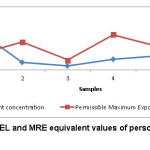 |
|
Graphical representation of dust concentrations in crusher observed over an 8 hour shift and the corresponding PLV based on individualistic calculations is shown in Figure 3. It was observed that a total of three (3) samples exceeded the PLV prescribed by the Factories Act 1948.
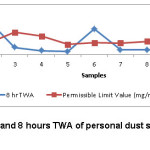 |
|
A scatter plot as depicted in Figure 4, was plotted for free silica estimated (mg) against the amount of dust collected (mg) to get an idea of the distribution of data. Pearson’s coefficient (r = 0.9756) as well as a p-value < 0.0001 indicated a very strong positive relationship between these two variables.
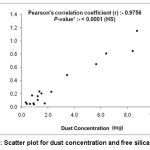 |
|
Discussion
A simple glance at the results of the study is enough to indicate that workers working in stone crushing plants were exposed to high levels of dust and free silica contained therein. A similar observation could also be made about the workers in the stone mines. High exposures as these pose serious occupational health hazards to the personnel working here.
During subjective evaluation of the working conditions of the said study area it was observed that the overall mining environment was less dusty as compare to the crushing plant. It was also observed that the scope of dispersion of the liberated dust was more in the mining area as compared to the crusher unit. Thus helpers at the crushing unit were highly exposed to respirable dust as compared to the HEMM operators in the mining area. The fact that the HEMM operators worked in enclosed cabins further helped reduce the exposure of the HEMM operators. Helpers in the crusher area were highly exposed to crystalline silica as compared to mining workers.
As portrayed in Figure 1 dust generation occurs during various stages at stone crushing units and in the stone mine. Grinding, cutting, drilling and loading are the prime operations in stone mining and crushing sector.
Sivacoumar et al (2006) had conducted a similar study on stone crushing units near Pammal, a suburban area of Chennai, India whereby he reported values of total and respirable particulate matter exceeding Indian National Standards.18 Gottesfeld et al (2008) in their research on crushing units of Khurda District of Orissa,India have reported absence of dust suppression mechanisms despite significant dust generation.6
In this particular case study, walk through surveys in the crushing units hinted at working environment being dusty and thereby unsafe. The same was ratified with the results of the study which exceeded the prescribed limits of statutory agencies.
A moderately similar study conducted by Semple et al (2008) measured respirable dust on two occasions for a total of 5 hours 27 minutes giving concentrations of 0.07 mg/m3 and 0.25 mg/m3.19 Results of our present study are higher to that of Semple et al (2008), in our study respirable dust exposure in stone mining area was observed between the 0.27-2.87 mg/m3 whereas, in stone crusher it was 0.38-8.27 mg/m3. Also, in both cases viz. stone mines and crushing unit, dust exposure for two (2) and three (3) samples respectively had exceeded the MEL and PLV values. Since a majority of the workers were exposed to high levels of dust containing free silica during the course of their work there is every possibility of serious health issues arising for the workers in the future. Exposure to dust and crystalline silica in stone quarry and crusher sector can lead to deterioration of pulmonary function20,21
Magne et al (2003) in his study has reported that exposure to crystalline silica in the range from 0.05 mg/m3-0.1 mg/m3 for a period ranging from 20 - 45 years is responsible for chronic silicosis and can also be considered as a human carcinogen.22 Further, Ugbogu et al (2000) in his study has also reported that small scale mining workers in developing countries are unaware of the impact of dust to which they are exposed unknowingly.23
The average age of workers participating in the dust survey was 31 years, with a reported average exposure of 6 years to dust laden silica in this industry. Interaction with the workers also revealed that a majority of the workers were unaware of silicosis and its impacts on health. It was observed that knowledge on the precautionary measures was lacking.
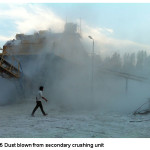 |
|
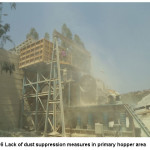 |
|
With respect to the case study, it is noteworthy to point out that differentiated responsibility for regulating and inspecting this sector are one of the reasons for poor implementation of dust prevention measures. Stone mining comes under the ambit of Indian Mining Act; however when the very same stone goes to the crushing unit for further crushing and grading, the resultant dust generation and its impact on man comes under the ambit of Indian Factories Act. Authors are of the opinion that, environmental pollution and occupational exposure are interlinked and this close link needs to be understood by the statutory agencies while implementation of regulations. Control of environmental dust concentration would ultimately decrease the concentration of personal dust exposure in the occupational environment.
Active implementation of intervention policy for control of exposure to silica laden dust is a necessity today. Issues such as silicosis in the stone mining and crushing sector which ultimately prove fatal for those at the lower end of the economic ladder should be accorded due priority by stressing on implementation of safety during operation. Awareness of the hazards of this industry and personal protective equipment for the workers employed here should be made compulsory thereby attempting to arrest the spread of silicosis instead of compensation to families of the deceased. Absence of dust suppression measures, uncovered conveyor belts, lack of plantation along mining periphery, absence of water spraying during loading and unloading of trucks, etc should be strictly tackled with so as to meet India’s commitment to eradicate silicosis by 2030.
The present study has attempted to portray the current situation of occupational dust and silica exposure in stone mines and crushing sector. This case study approach if adopted over a larger scale can help uncover the gist of the problem of safety and also its health impact in the Indian small scale stone mining sector.
Acknowledgment and funding source
Authors thankfully acknowledge the funding provided by Ministry of Mines & Ministry of Labour, Government of India for the project entitled “Multi Centric Study of Dust related Diseases in Stone Mines and Development of Sustainable Preventive Program”. Material reported in this research is collected within this project.
Conflict of interest
The authors declare no conflict of interest relating to the material presented in this article. Its contents, including any opinions and conclusions expressed, are solely those of the authors alone and do not necessarily reflect the policy of funding agency.
References
- Ministry of Mines., Mines and Minerals (Development and Regulation) Act. Ministry of Mines, Government of India, New Delhi (1957).
- Ministry of Mines., E-Book on Mining Sector. Ministry of Mines, Government of India, New Delhi (2016). http://www.mines.nic.in/writereaddata/UploadFile/ebookmines.pdf (accessed 12 Jan 2017)
- Mukhopadhyay Krishnendu., Ramalingam , Ramani Raghunathan., Dasu Venkatesan., Sadasivam Arulselvan., Kumar Pramod., Prasad Shyam Narayan., Sambandam Sankar., and Balakrishnan Kalpana. Exposure to respirable particulates and silica in and around the stone crushing units in central India. Journal of Industrial Health, (49): 221-227 (2011). doi:10.2486/indhealth.MS1207
- Amitshreeya R., and Panda R B. Dust pollution in stone crusher units in and around balasore, Orissa, India. Journal of Industrial Pollution Control, (28):41–4 (2012)
- Central Pollution Control Board (CPCB)., Comprehensive Industry Document Stone Crushers. Comprehensive Industry Document Series: COINDS/78/2007-08. 2009;:1–142.http://cpcb.nic.in/upload/NewItems/NewItem_148_STONE_CRUSHER_REPORT.pdf (accessed 12 Jan 2017).
- Gottesfeld Perry., Nicas MarkMARK., Kephart John W.,Balakrishnan Kalpana., Rinehart Richard., Reduction of respirable silica following the introduction of water spray applications in Indian stone crusher mills. International Journal of Occupational and Environmental Health, (14): 94–103 (2008) doi:10.1179/oeh.2008.14.2.94
- An Empirical Study of Stone Crushing Industries Established in Village Khanak, Bhiwani, Haryana. Abhinav International Monthly Refereed Journal of Research in Management & Technology, 3 (12): 18–23 (2014)
- Government of India. The Factories (Amendment) Act, 1984. India, (1987) http://bombayhighcourt.nic.in/libweb/actc/yearwise/1987/1987.20.pdf (accessed 21 March 2017)
- National Human Rights Commissions. NHRC Interventions on Silicosis. New Delhi (2016) http://nhrc.nic.in/Documents/Publications/NHRC_Interventions_on_Silicosis_27122016.pdf
- Lumens Mieke., and Spee Ton. Determinants of exposure to respirable quartz dust in the construction industry. Annals of Occupational Hygiene, 45 (7):585–595 (2001) doi:10.1016/S0003-4878(01)00025-4
- Occupational Knowledge International. Legislative Provisions Relating to Silica Exposure and Silicosis in India: The Need for Review ( 2009).
- Maxted Benton., Dust masks for Indian quarry workers: A comparative analysis of the filtering efficiency of fabrics. Journal of Humanitarian Engineering, 1 (1): 15-20 (2012)
- Central Pollution Control Board (CPCB). National Ambient Air Quality Standards: 1–4 (2009) http://cpcb.nic.in/National_Ambient_Air_Quality_Standards.php (accessed 11 May 2017).
- Ministry of Environment Forest and Climate Change (MoEF&CC). The Environment (Protection) Act, (1986) http://envfor.nic.in/legis/env/env1.html (accessed 11 May 2017).
- Singh VK, N. Sahay, J. K. Pandey, S. K. Ray., Kumar A and Mondal P C., Report on Performance Evaluation of Personal Dust Sampler (Make-M/s SKC Inc, U.S.A Model-Side Kick-51Ex.), Dhanbad, (2003)
- National Institute of Occupational Safety and Health (NIOSH)., Manual of Analytical Methods (NIMAM), Fourth Edition. (2003)
- C. Kaku. D. G. M. S. Circulars. Dhanbad: Lovely Prakashan; 2013.
- Sivacoumar R., Jayabalou R., Swarnalatha S., and Balakrishnan K. Particulate Matter from Stone Crushing Industry : Size Distribution and Health Effects. Journal of Environmental Engineering,132 (3): (2006)
- Semple S, Green D a, McAlpine G, Cowie H, Seaton Exposure to particulate matter on an Indian stone-crushing site. Occupational and environmental medicine [Internet].;(65):300–5 (2008). Available from: http://www.ncbi.nlm.nih.gov/pubmed/17681995 (accessed 8 November 2017)
- Mirdha P, Solanki S, Singh B. Deterioration of pulmonary function with duration of exposure to silica dust in stone crusher workers. Indian Journal of Clinical Anatomy and Physiology.( 3):544–6 (2016)
- Kiran Kumar CH, Mallikarjuna Reddy N, Singh M SB, Krishna BH, Sasikala P, ShravyaKeerthi G, et al. Deterioration of pulmonary function in stone quarry workers. Biomedical Research (India).(25):261–8 (2014)
- Bratveit Magne., Moen Bente., Mashalla Yohana., and Maalim Hatua. Dust Exposure During Small-scale Mining in Tanzania :A Pilot Study. Annals of Occupational Hygiene ,47 (3): 235-240 (2003) doi:10.1093/annhyg/meg027
- Ugbogu O C., Ohakwe J., and Foltescu V. Occurrence of respiratory and skin problems among manual stone-quarrying workers. African Journal of Respiratory Medicine: 23-26 (2009) http://www.africanrespiratory.com/articles/march_2009/Occurrence of respiratory and skin problems among manual stone-quarrying workers.pdf (accessed 6 May 2017)






